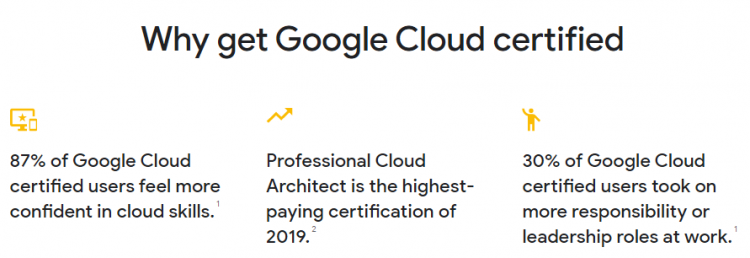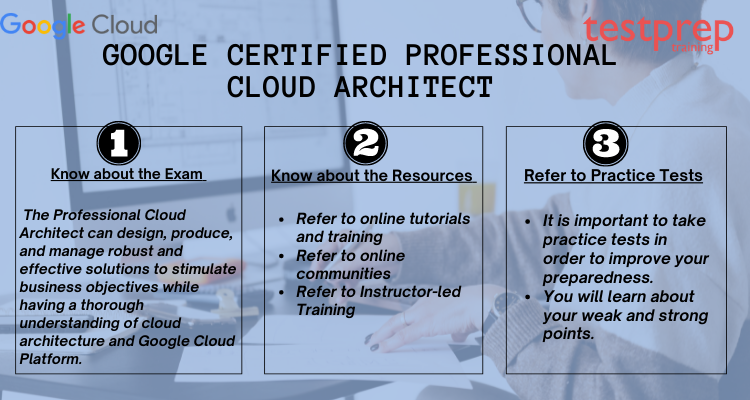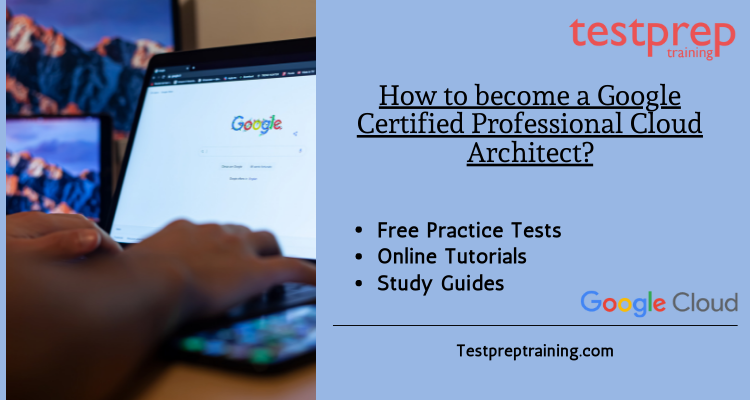More and more businesses are turning to cloud services, which has increased the demand for people with this expertise. As a result, understanding how to use a cloud service has become critical. If you want to work in modern software systems, becoming a Google Certified Professional Cloud Architect is a good place to start. It’s past time for a wake-up call if you haven’t learned about cloud technology. Cloud technology, on the other hand, is unavoidable in today’s world. In other words, you cannot ignore this technology while working in the IT industry.
Let us know the key steps to become a Google Certified Professional Cloud Architect!
About Google Certified Professional Cloud Architect
A Professional Cloud Architect enables businesses to take advantage of Google Cloud technologies. The Professional Cloud Architect can design, produce, and manage robust, secure, scalable, highly available, and effective solutions to stimulate business objectives while having a thorough understanding of cloud architecture and Google Cloud Platform. Google Cloud certifications validate the candidate’s knowledge and demonstrate their ability to convert businesses using Google Cloud technology.

Google Certified Professional Cloud Architect Requirements
Every other exam is not open to everyone. As a result, it is critical for the aspirant to thoroughly read the Google Certified Professional Cloud Architect Eligibility section.
- To begin, a solid understanding of Google’s technology cloud architecture is required.
- Capability to design, develop, and manage solutions that are secure, robust, highly scalable, available, and dynamic.
- Proficiency in various aspects of solution development, including prototype development, implementation details, and best architectural practices.
- Lastly, Extensive knowledge of multi-tiered distributed applications and micro-services
Let us now move to the main part of this blog –
How to become a Google Certified Professional Cloud Architect?
There is no denying that Google Professional Cloud Architect is essential in advancing one’s career. In other words, once you pass the exam, you will be well on your way to success. Follow these steps to become a Google Certified Professional Cloud Architect –

Step 1 – Know in-depth about the exam syllabus
Below mentioned is the detailed course outline for the exam along with the documentation and whitepapers offered by google –
Domain 1: Designing and planning a cloud solution architecture (24%)
1.1 Designing a solution infrastructure that meets business requirements. Considerations include:
- Business use cases and product strategy (Google Documentation: Best practices for enterprise organizations, Implementing policies for customer use cases)
- Cost optimization (Google Documentation: Performance and cost optimization)
- Supporting the application design (Google Documentation: Google Cloud system design considerations)
- Integration with external systems (Google Documentation: Using APIs from an External Network, Security, privacy, and compliance)
- Movement of data (Google Documentation: Data lifecycle)
- Design decision trade-offs (Google Documentation: Google Cloud system design considerations)
- Build, buy, or modify
- Success measurements (e.g., key performance indicators [KPI], return on investment [ROI], metrics) (Google Documentation: KPIs for APIs: How Metrics Change Over Time)
- Compliance and observability (Google Documentation: Security, privacy, and compliance)
1.2 Designing a solution infrastructure that meets technical requirements. Considerations include:
- High availability and failover design (Google Documentation: Overview of the high availability configuration)
- The elasticity of cloud resources (Google Documentation: Google Cloud overview)
- Scalability to meet growth requirements (Google Documentation: Reliability, Security, privacy, and compliance)
- Performance and latency (Google Documentation: Performance and cost optimization)
1.3 Designing network, storage, and compute resources. Considerations include:
- Integration with on-premises/multi-cloud environments (Google Documentation: Hybrid and multi-cloud architecture patterns)
- Cloud-native networking (VPC, peering, firewalls, container networking) (Google Documentation: VPC network overview)
- Choosing data processing technologies (Google Documentation: Data processing, Dataflow, Dataproc)
- Choosing appropriate storage types (e.g., object, file, RDBMS, NoSQL, NewSQL) (Google Documentation: Google Cloud Databases)
- Choosing to compute resources (e.g., preemptible, custom machine type, specialized workload) (Google Documentation: Compute, Creating a VM Instance with a custom machine type)
- Mapping compute needs to platform products (Google Documentation: Google Cloud products)
1.4 Creating a migration plan (i.e., documents and architectural diagrams). Considerations include:
- Integrating solution with existing systems (Google Documentation: Migration to Google Cloud: Getting started)
- Migrating systems and data to support the solution
- Licensing mapping (Google Documentation: Bringing your own licenses)
- Network planning (Google Documentation: Best practices and reference architectures for VPC design, VPC network overview))
- Testing and proof of concept (Google Documentation: Running a hybrid render farm proof of concept)
- Dependency management planning (Google Documentation: Specifying Dependencies)
1.5 Envisioning future solution improvements. Considerations include:
- Cloud and technology improvements (Google Documentation: Google Cloud Improvements)
- Business needs evolution (Google Documentation: Best practices for enterprise organizations, Google Cloud Improvements)
- Evangelism and advocacy (Google Documentation: API Team Best Practices: Developers, Evangelists, and Champions)
Domain 2: Managing and provisioning a solution Infrastructure (15%)
2.1 Configuring network topologies. Considerations include:
- Extending to on-premises (hybrid networking) (Google Documentation: Extending On-Premises Network-Attached Storage to Cloud Storage with Komprise, Google Cloud Hybrid Connectivity)
- Extending to a multicloud environment that may include Google Cloud to Google Cloud communication (Google Documentation: Hybrid and multi-cloud architecture patterns)
- Security protection (e.g. intrusion protection, access control, firewalls)
2.2 Configuring individual storage systems. Considerations include:
- Data storage allocation (Google Documentation: Best practices for Cloud Storage)
- Data processing/compute provisioning (Google Documentation: Provisioning VMs on sole-tenant nodes, Data processing, Dataflow, Dataproc)
- Security and access management (Google Documentation: Identity and Access Management)
- Network configuration for data transfer and latency (Google Documentation: GCP network performance, Performance, and cost optimization)
- Data retention and data life cycle management (Google Documentation: Data lifecycle, Retention policies and retention policy locks)
- Data growth management (Google Documentation: Data lifecycle, Cloud storage growth)
2.3 Configuring compute systems. Considerations include:
- Compute system provisioning (Google Documentation: Provisioning VMs on sole-tenant nodes, Compute Engine)
- Compute volatility configuration (preemptible vs. standard) (Google Documentation: Preemptible VM instances, Creating and starting a preemptible VM instance)
- Network configuration for compute resources (Google Compute Engine, Google Kubernetes Engine, serverless networking)
- Infrastructure orchestration, resource configuration, and patch management
- Container orchestration
Domain 3: Designing for security and compliance (18%)
3.1 Designing for security. Considerations include:
- Identity and access management (IAM) (Google Documentation: Identity and Access Management)
- Resource hierarchy (organizations, folders, projects) (Google Documentation: Resource hierarchy, Using resource hierarchy for access control)
- Data security (key management, encryption) (Google Documentation: Encryption at rest in Google Cloud)
- Separation of duties (SoD) (Google Documentation: Separation of duties)
- Security controls (e.g., auditing, VPC Service Controls, organization policy) (Google Documentation: Overview of VPC Service Controls)
- Managing customer-managed encryption keys with Cloud KMS (Google Documentation: Customer-managed encryption keys (CMEK))
- Remote access
3.2 Designing for compliance. Considerations include:
- Legislation (e.g., health record privacy, children’s privacy, data privacy, and ownership) (Google Documentation: Compliance resource center)
- Commercial (e.g., sensitive data such as credit card information handling, personally identifiable information [PII]) (Google Documentation: Scan for sensitive data in just a few clicks, Take charge of your sensitive data with the Cloud Data Loss Prevention (DLP) API)
- Industry certifications (e.g., SOC 2) (Google Documentation: SOC 2)
- Audits (including logs) (Google Documentation: Cloud Audit Logs)
Domain 4: Analyzing and optimizing technology and business processes (18%)
4.1 Analyzing and defining technical processes. Considerations include:
- Software development life cycle plan (SDLC)
- Continuous integration / continuous deployment (Google Documentation: Setting up a CI/CD pipeline)
- Troubleshooting / root cause analysis best practices
- Testing and validation of software and infrastructure (Google Documentation: Validate Your Data, Testing Overview)
- Service catalogue and provisioning (Google Documentation: Provisioning Overview)
- Business continuity and disaster recovery (Google Documentation: Disaster recovery planning guide, Solving for business continuity)
4.2 Analyzing and defining business processes. Considerations include:
- Stakeholder management (e.g. influencing and facilitation)
- Change management (Google Documentation: Opening doors, embracing change with cloud data warehouses)
- Team assessment/skills readiness (Google Documentation: Migration to Google Cloud: Assessing and discovering your workloads)
- Decision-making process
- Customer success management
- Cost optimization / resource optimization (Capex / Opex) (Google Documentation: Cloud cost optimization, Cost Management)
4.3 Developing procedures to ensure reliability of solutions in production (e.g., chaos engineering, penetration testing) (Google Documentation: Patterns for scalable and resilient apps)
Domain 5: Managing implementation (11%)
5.1 Advising development/operation team(s) to ensure successful deployment of the solution. Considerations include:
- Application development (Google Documentation: Application modernization, Application Development)
- API best practices (Google Documentation: API Key Best Practices)
- Testing frameworks (load/unit/integration) (Google Documentation: Testing Overview, test – Run gsutil unit/integration tests (for developers))
- Data and system migration tooling (Google Documentation: Data center migration)
5.2 Interacting with Google Cloud programmatically. Considerations include:
- Google Cloud Shell
- Google Cloud SDK (gcloud, gsutil and bq)
- Cloud Emulators (e.g. Cloud Bigtable, Datastore, Spanner, Pub/Sub, Firestore)
Domain 6: Ensuring solution and operations reliability (14%)
6.1 Monitoring/logging/profiling/alerting solution (Google Documentation: Introduction to alerting, Alerting behavior)
6.2 Deployment and release management (Google Documentation: Google Cloud Deployment Manager)
6.3 Assisting with the support of solutions in operation (Google Documentation: Cloud Monitoring, Operations)
6.4 Evaluating quality control measures (Google Documentation: Google security whitepaper)
Step 2 – Know about the Exam Format
Another thing that the candidate should be aware of is the fundamentals of the exam. Details such as exam length, fee, number of questions, and so on. As a result, we’re talking about it here. The Google Certified Professional Cloud Architect exam consists of multiple-choice questions, and the candidate will have 2 hours to complete it. The cost of becoming a Google Certified Professional Cloud Architect is $200. (plus tax where applicable). The exam is available in both English and Japanese.
Step 3 – Gather all other important details about the exam
These are some policies of which you should be aware of when you will be taking this exam –
Rescheduling policy – Make an effort to take your exam on a predetermined date and time. For example, if you fail to take the exam on the scheduled date, you must look into the reschedule/cancel policy. By logging into your Proctor U account, you can cancel or reschedule your exam. Make sure you do this 48 hours or two days before the exam, or you will have to pay fees.
Retake Policy – This is one of the most frequently asked questions when deciding whether or not to take the exam. Nobody wants to fail an exam, especially when their certification is on the line. However, if you fail the exam the first time, you must wait 14 days before taking it again. Above all, each time you retake the exam, you must pay the full fee. If you fail a second time, the wait time increases to 60 days, and you must wait 365 days before attempting again.
Step 4 – Refer to the best Resources
Different resources have various sets of knowledge and understandings. However, revision should be something that is done on a case-by-case basis in academic life. As a result, it is critical to match the type of revision you are performing on your resource material.
Google Cloud Platform Documentation
After the exam guide, this is the second most important thing to study. It will assist you in comprehending all aspects of the Google Cloud Platform from the standpoint of a developer. It refers to detailed documentation, guides, and resources for Google Cloud Platform products and services. Furthermore, once your certification is complete, it can serve as a tool to assist you in deciding which real-world application to work with based on GCP.
Google Cloud Solutions Reference Guide
GCP (Google Cloud Platform) is essentially a collection of cloud computing services. It assists you in resolving your most difficult business challenges and exploring new opportunities with Google Cloud. In other words, this is a simple reference guide for everything that can be done with the Google Cloud Platform. This guide is unique in that it also lists various companies that collaborate with Google Cloud to create and run them. As a result, by the time you finish studying the material, you will have a working knowledge of all the major and minor players in the industry.
Google Cloud Platform Blog
Changes in the cloud lead to changes in the policies that govern it. It is difficult to keep up with the latest developments in the field with the advent of new technologies and ever-changing political policies. This barrier, however, can be overcome if you have a reliable source of information. The Google Cloud Platform blog is the place to be. Furthermore, by visiting this blog regularly, you will always have the most up-to-date information whenever you decide to take the exam.
Practice exam and Mock Tests
Google Certified Professional Cloud Architect Practice Tests are similar to final exams in that the paper pattern is similar, as is the marking scheme used to determine actual potential and iron out weaknesses. In other words, the primary goal of the mock test is to identify your strong and weak points. A mock test gives you an idea of what the final exam will be like. It assists you in analyzing yourself and determining where you stand. Furthermore, it provides you with a score at the end to let you know how you fared. Testprep Training provides free and paid practice tests for the Google Cloud Architect exam. You can take the practice test right now by clicking the following link:
TRY the Google Certified Professional Cloud Architect Free Practice Tests Now!
Step 5 – Take the exam in accordance with the Expert’s Advice
Once you’ve read all of the pertinent exam information, it’s time to devise your strategy for passing the exam. Furthermore, when an exam is approaching, it is often easier to prepare by using a study guide. As stated in the preceding article, the Google Cloud Architect Certification Exam is dynamic, necessitating the development of an equally dynamic exam strategy.
It becomes critical that you organize your time and allow yourself enough time to study. To put it another way, don’t put it off until the last minute. Cramming at the last minute is not the best way to prepare for an exam. This bet could cost you your certification. It is recommended that you create a timetable and organize your studies accordingly. You cannot risk jeopardizing your certification due to your laziness.
Remember that obtaining the Google certificate professional cloud architect opens up a plethora of opportunities in the IT industry. You are fortunate in that we have your back. Testprep Training offers a series of practice tests that will boost your confidence to the point where you will be able to pass the certification exam on the first try.




